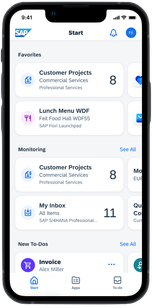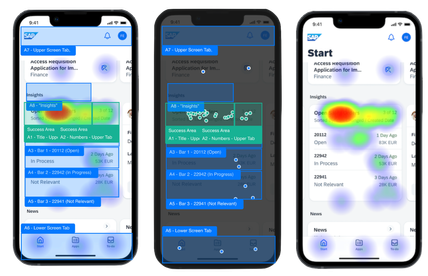
- SAP Community
- Products and Technology
- Enterprise Resource Planning
- ERP Blogs by SAP
- User-Centered Design & Development: The Role of Us...
- Subscribe to RSS Feed
- Mark as New
- Mark as Read
- Bookmark
- Subscribe
- Printer Friendly Page
- Report Inappropriate Content
By Dominic Norcross (UX Research Associate)
At SAP, one of our main goals is to create apps that delight our customers and offer a seamless user experience. One key pillar to achieve this goal is user centricity – making sure the user’s voice is heard and considered in the design and development of new features. This is exactly why User Research plays a vital role in app design and development, including SAP Mobile Start.
What is User Research?
User Research (UR) is tasked with studying users’ behaviors, perceptions, needs, and pain points. The starting point of every research is the research question. SAP Mobile Start’s designers and researchers are in constant exchange to expose problems and design opportunities that require user insights. User Research ensures both high usability (easy and intuitive usage of the app) and great user experience (usage experience, including aesthetic and emotional factors). The questions that are answered can range from high-level aspects such as personalization concepts to specific details such as visual KPI representations in ‘interest cards’.
User Research Methods
To answer questions like these, User Research can rely on a spectrum – and often a combination of – different methods depending on the questions at hand. Most basically, they can be differentiated by whether activities are moderated or unmoderated.
Moderated User Research
In formats such as interviews or usability tests, users are guided through the session by a researcher. The researcher acts as a moderator. Also, a trained note-taker is present. In this 1:1 setting, each individual user’s insights can be collected on a deep level as the moderator can directly observe unexpected behaviors and ask as many follow-up questions as arise.
Whether in person or remotely, users are often asked to interact with first mockups or low-fidelity prototypes directly on their mobile phone. They can be given a range of different tasks related to the research topic, e.g.: “Personalize the Start screen by hiding the news section from the Start screen.” During the interview, the users’ expectations, their behavior while performing the task, but also their thoughts after completing the task are noted systematically for later analysis.
In a typical setup for a remote usability test, the user shares his mobile screen, but also shows his interactions via the camera.
Above you can see an example of a low-fi mockups and sketch and a high-fidelity prototype
(please note: the designs shown are merely early design explorations and do not represent concrete features of the app).
Unmoderated User Research
To complement moderated User Research insights, of course also quantitative methods of collecting user feedback/behavior are deployed.
User Research is leveraging online tools to get insights from a statistically significant number of users in even smaller timeframes, as no live moderation is required. In so-called unmoderated studies, users can provide feedback easily and quickly whenever and wherever they are. In addition to answering survey-like questions to help understand their wishes and pain points, they also interact with mobile screens, low-fi mockups, and prototypes in different task types.
In a click task, the users are asked to click on a mobile screen (typically just once). This shows the researcher their intuitive starting point to tackle a specific task and correlates highly with the expected overall task success rate.
In interactive prototype tasks, the users are asked to fulfil a certain task by using a high-fidelity prototype that offers many different logical branches and alternative paths. Importantly, all interactions with the prototype are recorded for later analysis. In certain scenarios, users are also asked to “think out loud (TOL)” while they are completing these tasks. The recorded ‘TOL’ audio in combination with the screen recording further helps User Researchers to understand which issues users are experiencing. Of course, these are merely examples of the diverse set of methods employed to create meaningful user insights.
By the way: There is another unmoderated way in which SAP Mobile Start gathers feedback, the so-called ‘In-App Feedback’. Every live user of SAP Mobile Start can click on the settings and use the ‘leave feedback’ button. Where possible, users are also given the opportunity to give feedback directly in the app while using specific features. Of course, we try to ensure this is configured in a way that is minimal and non-disruptive to the usage experience.
User Research Data and Insights
The data created from User Research still must be analyzed, understood, and mapped to concrete insights for designers and developers to improve the app. There is a range of ways in which data can be aggregated and visualized dependent on the chosen method. To name a couple of examples, Heat Maps provide us with a clear overview of where the users spontaneously clicked to achieve a specific goal, whereas Click Paths show the exact path of all individual users going through a prototype. Furthermore, data such as task success rates, task completion times, but also time spent in certain parts of the prototype are considered. Thanks to insights like these, the SAP Mobile Start team can identify improvement opportunities to optimize the future user experience.
Heat Maps help visualize the users’ most used sections on certain screens.
Click Paths show how users navigated through a prototype, illustrating which turns or possible workarounds
they took to achieve a task in the tested system, instead of staying on the ‘golden path’. (Above is an excerpt of a Click Path.)
Putting the User in User Research
Hopefully, these insights into User Research for SAP Mobile Start were interesting for you. As you have learned, User Research relies both on objective user behavior observations as well as subjective user feedback that can be provided flexibly in different ways. No matter how feedback is provided, it reaches our team directly and helps shape the future of the app to reach its full potential of user centricity.
Feel free to post your questions or feedback about User Research and SAP Mobile Start in the Q&A area. Start by visiting your SAP Mobile Applications community page and click “Follow”. We’ll be publishing more informative blog posts.
- SAP Managed Tags:
- SAP Build Work Zone, standard edition,
- SAP Mobile Start,
- User Experience
You must be a registered user to add a comment. If you've already registered, sign in. Otherwise, register and sign in.
-
Artificial Intelligence (AI)
1 -
Business Trends
363 -
Business Trends
24 -
Customer COE Basics and Fundamentals
1 -
Digital Transformation with Cloud ERP (DT)
1 -
Event Information
461 -
Event Information
24 -
Expert Insights
114 -
Expert Insights
159 -
General
1 -
Governance and Organization
1 -
Introduction
1 -
Life at SAP
415 -
Life at SAP
2 -
Product Updates
4,684 -
Product Updates
219 -
Roadmap and Strategy
1 -
Technology Updates
1,502 -
Technology Updates
89
- SAP S4HANA Cloud Public Edition Logistics FAQ in Enterprise Resource Planning Blogs by SAP
- ISAE 3000 for SAP S/4HANA Cloud Public Edition - Evaluation of the Authorization Role Concept in Enterprise Resource Planning Blogs by SAP
- Automate [Inventory Valuation Simulation Report] in SAP Business One in Enterprise Resource Planning Q&A
- SAP S/4HANA Cloud, public edition, ABAP Environment Case 8: Material Shelf Life Management in Enterprise Resource Planning Blogs by SAP
- Workflow Flexible not going to My Inbox until SWU_OBUF in Enterprise Resource Planning Q&A
| User | Count |
|---|---|
| 11 | |
| 10 | |
| 9 | |
| 7 | |
| 7 | |
| 7 | |
| 6 | |
| 5 | |
| 4 | |
| 4 |




